Brightening the drab floor of our mini woodland in our dry winters, this member of the Amaryllidaceae family flowers freely.
Its botanical name, Haemanthus albiflos, means blood flower (Heamanthus) white flowers (albiflos), which sounds contradictory, but the blood part of the name is because many species of Haemanthus have red flowers.
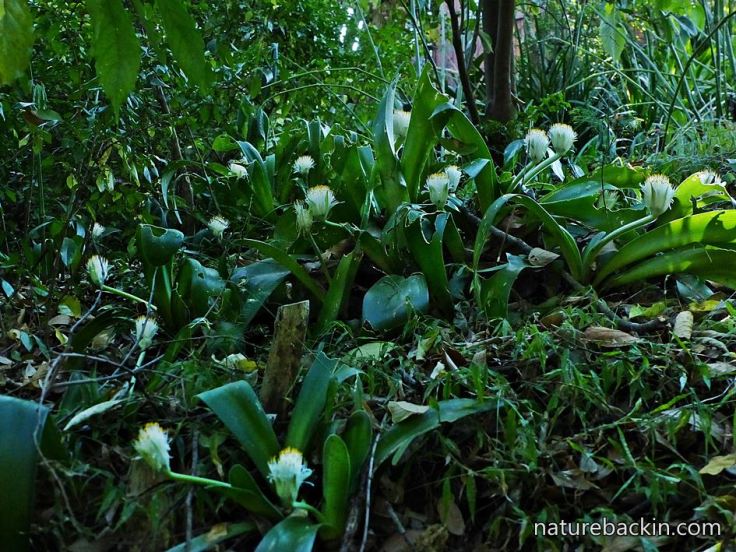
Naturally, Haemanthus albiflos grows in dappled shade in woodlands, forests and thickets, and occurs along the southern and eastern coastal belts of South Africa
In our garden it grows in the shade of trees and shrubs, and we just leave it to its own devices and it flowers reliably every year. The fallen leaves from the deciduous trees provide it with a decent mulch, perfect growing conditions for this low-growing plant. Some of the plants are solitary, but most form clumps that increase in size and density each year, making it a good ground cover in shady areas.

The flower heads are very showy
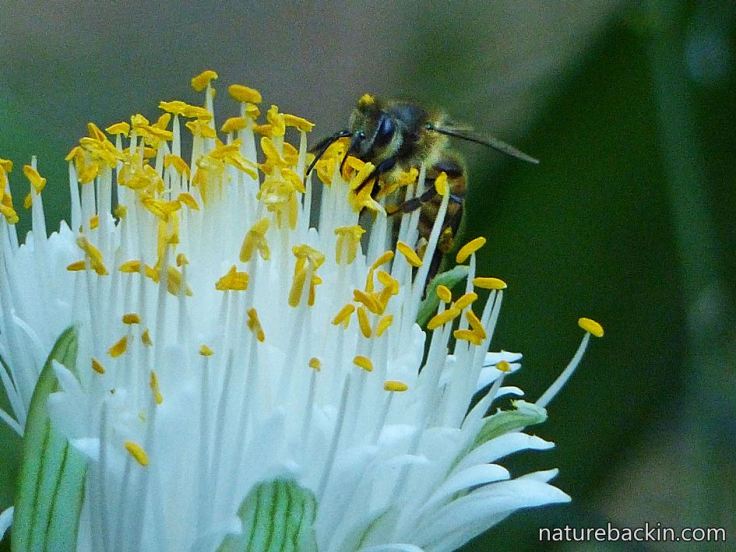
The bees like them too
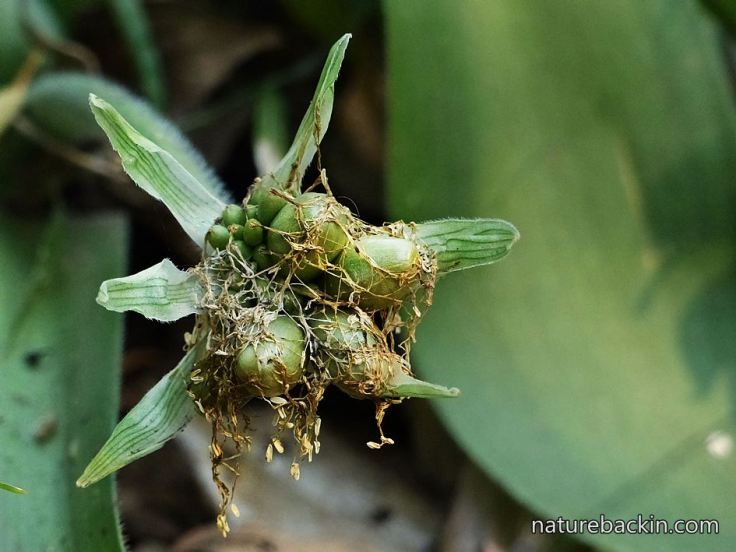
As the flowers go over and the stamens hang down like the remains of a desiccated bridal veil, the seed berries start to swell

Eventually the berries ripen to an orangey-red. I have had to keep an eye out to get this photograph, because as soon as the berries ripen they get eaten, I assume by birds but maybe also by small mammals, such as the Slender Mongoose (see here)
It is nice to have this drought-resistant plant providing food for wildlife at the end of winter when times are tough. This season, conditions are particularly harsh. We last had decent rain in May. This spring we have had only two rainy days so far, with each of these days providing less than a millimeter of rain. No rain at all is predicated in the current long-range 10-day forecast, but daytime temperatures are set to rise to well over 30 degrees C.
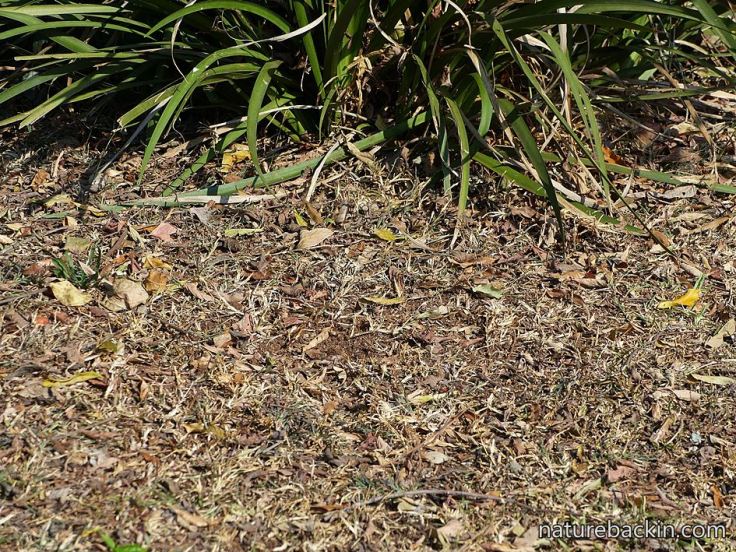
This is what our lawn looks like
Here in KwaZulu-Natal, the level of water in our dams (that serve as reservoirs) is nowhere near as critical as it is in the Western Cape, but no rain and high temperatures are taking their toll. It goes without saying that using hosepipes for such non-essentials as lawns is just not right, and in many areas the use of hosepipes is prohibited, and other restrictions to limit the use of water are also in place.
We have decided not to plant vegetables until the rains come. In the meantime, self-seeded veggies and herbs are providing some cover and food, and we water the veggie patch occasionally using a watering can. Our rainwater tanks are still storing some water from last season’s rains and we have put in some pipes that catch the bath/shower water so as to gravity feed it into parts of the garden, but these are feeble efforts in the face of the drought.
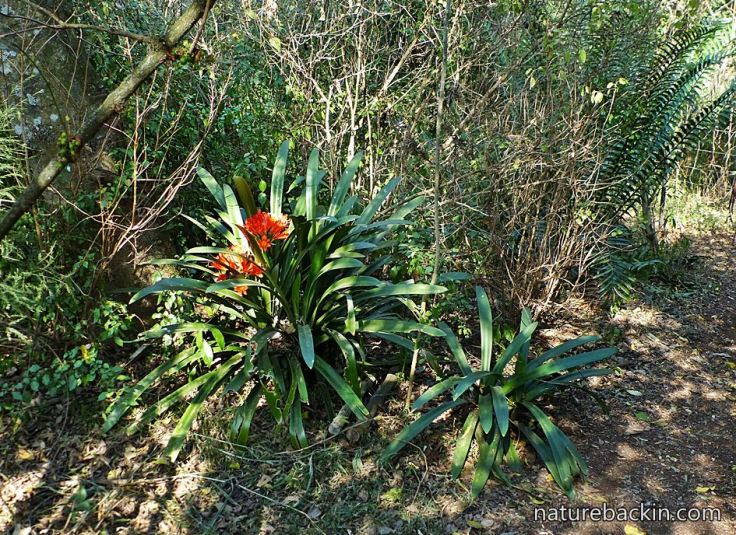
Another forest dwelling plant, Clivia miniata, has managed to flower this spring, while all around it appears to be in virtual lockdown, awaiting the rain
Most of our garden plants are indigenous and able to survive periods of drought. Many also, are able to provide at least some food for birds and other wildlife. At times like these, it is a relief to have a garden of hardy plants, most of which will survive the hard times (I hope) and I am very pleased not to have a rose garden.
Source: Pooley, Elsa. 1998. A Field Guide to Wild Flowers of KwaZulu-Natal and the Eastern Region. Durban: Natal Flora Publications Trust.
Posted by Carol









September 10, 2017 at 8:35 am
It feels as if we’ve recently had nothing but rain here in the northern UK, and yet the level of water in rivers and reservoirs tells a very different story. It’s hard for us to imagine real drought, and I’m glad that your white paint brush offers a little moisture to the creatures who call your garden their home.
LikeLiked by 1 person
September 11, 2017 at 8:10 pm
Strange that the rainy weather in northern UK has not translated into full rivers and reservoirs – I suppose it depends on the rain in the catchment areas? We are geared for dry seasons and periodic droughts, but drought conditions are widespread and unusually prolonged, especially in some areas. In some towns and regions there have been periods when the taps have run dry, or surface water that people (and animals) depend on has dried up. Scary times.
LikeLiked by 1 person
September 7, 2017 at 8:04 pm
You could almost be describing my garden – certainly our lawns look much the same. Our clivias are getting ready to bloom and my Haemanthus albiflos is over.
LikeLiked by 1 person
September 7, 2017 at 8:44 pm
Sorry that your lawn looks the same! Glad though that your clivias are coming into flower. The Haemanthus “berries” are starting to ripen. Do you also find that the ripe berries get eaten up quite quickly?
LikeLike
September 7, 2017 at 7:57 pm
Such delicate, beautiful flowers…or at least they seem delicate. It’s amazing that they can flourish with such little water. I do prefer plants that I can just leave on their own.
LikeLiked by 1 person
September 7, 2017 at 8:40 pm
They are delicate but protected in their shady areas. They grow from tubers, which I guess store enough moisture to enable the flowers to flourish in the winter (which is our dry season). I also prefer plants that do well without needing much intervention or inputs, and so many indigenous plants do just that if planted in appropriate spaces 🙂
LikeLike
September 7, 2017 at 6:35 pm
Lovely flowers.
LikeLiked by 1 person
September 7, 2017 at 8:45 pm
Thanks Rupali.
LikeLiked by 1 person
September 7, 2017 at 6:25 pm
Smashing. Our clivias opened yesterday! An orange treat.
LikeLiked by 1 person
September 7, 2017 at 7:34 pm
Thanks Ark. Yes, clivias are an orange treat indeed, and very welcome in the generally dusty drabness of the drought.
LikeLike
September 7, 2017 at 5:47 pm
A beautiful flower wonderfully photographed.
LikeLiked by 1 person
September 7, 2017 at 7:32 pm
Thanks so much Belinda. White flowers and dappled shade are both challenging for me and my camera, so I had to fiddle with the exposure to try to cope with the contrasts.
LikeLiked by 1 person
September 7, 2017 at 5:44 pm
Such a wonderful post with beautiful photography!
LikeLiked by 1 person
September 7, 2017 at 7:28 pm
Thanks very much Pete.
LikeLiked by 1 person
September 7, 2017 at 5:34 pm
A beautiful and interesting flower – all stamens! I love the tough clivia, a houseplant here that blooms in winter. I hope you get some rain before summer sets in.
LikeLiked by 1 person
September 7, 2017 at 7:26 pm
Thanks Eliza. Yes it is an interesting flower. How lovely to have clivias flowering indoors in winter! Thanks for the wishes for rain – we are in a summer rainfall region in an area known as the mistbelt. We are hoping for rain, and wondering when we will see mist again.
LikeLiked by 1 person
September 7, 2017 at 5:25 pm
Drought is such a serious issue for wildlife – I am glad that they do restrict the use of hoses in your area and unsurprised that you go further in your quest to give rather than take from nature. I wish you rains. Plentiful rains. And soon.
LikeLiked by 1 person
September 7, 2017 at 7:22 pm
Thanks Osyth. I don’t remember ever experiencing such a dry spring. Some of the plants are budding, but others seem to be holding on, perhaps needing rain as a trigger. Even a little rain would be welcome now!
LikeLiked by 1 person
September 7, 2017 at 7:28 pm
Water really is the staff of life 🙂
LikeLiked by 1 person
September 7, 2017 at 3:12 pm
One of my favourites too. Flowering in the very dry understorey in Umgeni Valley Nature Reserve now. Must get some for my Howick garden. Yes, this hot dry weather is very disconcerting. Assume all the lugging of bath and dish water into the veggie patch is good for me though!
LikeLiked by 1 person
September 7, 2017 at 7:19 pm
Thanks Nikki. Its nice to know they are still flowering at Umgeni despite the dryness and the heat, which are both really disconcerting. Here, there was a worrying fire in a nearby plantation this afternoon. The frogs are very noisy tonight – wonder what they know?
Lugging water around is good for the plants, but not sure if it is that good for our hands and backs!
LikeLike